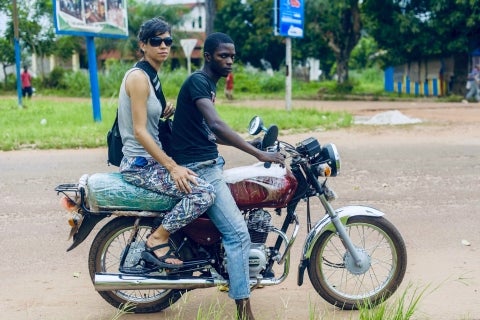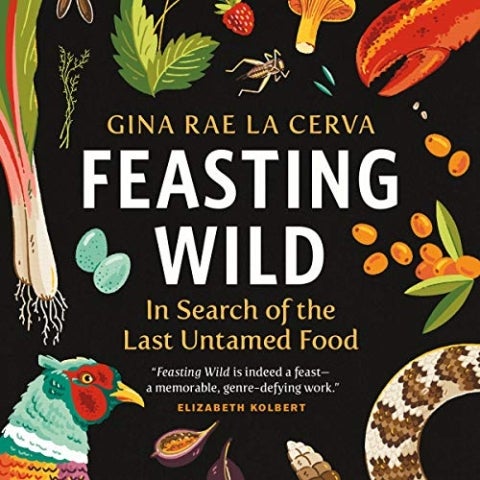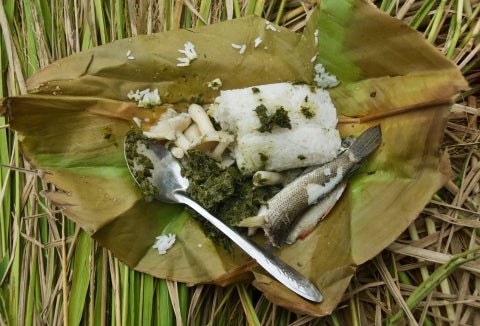Note: Yale School of the Environment (YSE) was formerly known as the Yale School of Forestry & Environmental Studies (F&ES). News articles and events posted prior to July 1, 2020 refer to the School's name at that time.
 Gina Rae La Cerva traveled extensively for "Feasting Wild," including to the Democratic Republic of Congo to investigate the violent "bush meat" markets, where meat from wild and exotic animals are sold to luxury consumers around the world.
Gina Rae La Cerva traveled extensively for "Feasting Wild," including to the Democratic Republic of Congo to investigate the violent "bush meat" markets, where meat from wild and exotic animals are sold to luxury consumers around the world.
Many Americans tend to their vegetable gardens, frequent local farmers markets, and try to buy organic, free-range foods, free from chemicals and preservatives — all in an effort to be healthy and sustainable. But few of us still, for a number of reasons, adhere to traditional methods of hunting and foraging to acquire our food.

In her debut book, “Feasting Wild: In Search of the Last Untamed Food,” Gina Rae La Cerva ’15 M.E.Sc. chronicles our relationship to “wild foods” by tracing the shift in America from foraging and hunting to wild foods becoming expensive luxuries. For the book, La Cerva traveled around the world to find people who depend on wild foods for survival and explore how ever-expanding markets are invading these untamed landscapes.
“Feasting Wild” has received glowing reviews and recommendations from The New York Times and Outside Magazine, and received praise on social media from author Michael Pollan and environmentalist Bill McKibben.
We recently spoke with La Cerva to dig deeper into some of the book’s key points and discussed how her time at F&ES helped inspire her writing.
“Feasting Wild” has received glowing reviews and recommendations from The New York Times and Outside Magazine, and received praise on social media from author Michael Pollan and environmentalist Bill McKibben.
We recently spoke with La Cerva to dig deeper into some of the book’s key points and discussed how her time at F&ES helped inspire her writing.
How did you come up with the idea for this book?
The seed was planted during my second semester at F&ES, when I attended a lecture at the Yale Himalaya Initiative about the caterpillar fungus (Ophiocordyceps Sinensis) — a parasitic fungus that grows on the Tibetan plateau and infects the caterpillar moth, eventually growing through and consuming the body of the insect. People harvest the half caterpillar/half-fungus and use it as a medicine and aphrodisiac. It has become incredibly expensive and, as a result, much of the trade is entangled in a violent black market.
That got me started thinking about our desire for wild things, for foods and medicines we cannot make ourselves. I started noticing a larger pattern: numerous wild foods that we gathered or hunted for free for 99 percent of our history were becoming luxury commodities, often acquired through criminal trade networks. At the same time, I was learning about the Anthropocene in my classes — this idea that humans have impacted every square inch of the planet, whether through climate change, land use or micro plastics. It seemed we were craving the last rare “wild” foods at a time when “wild” nature might cease to exist at all; I found that juxtaposition really interesting.
Your research required a lot of travel. How did you choose the places you visited? What was the experience like?
I am incredibly grateful to the various Yale organizations that funded the field work for this book, and it was also through these groups that I found many of my research contacts. I knew I wanted to look at the wild meat trade in Africa, because it is transitioning from a subsistence food to a luxury meal; I ended up in the Democratic Republic of Congo through contacts from various Yale professors. It was similar with the research on Edible Bird’s Nests, which took me to Borneo. The chapter set in Poland is rooted in my experiences on the Yale-Technical University of Munich (TUM) exchange trip. In many ways, the places I went were a direct result of the Yale network.
The seed was planted during my second semester at F&ES, when I attended a lecture at the Yale Himalaya Initiative about the caterpillar fungus (Ophiocordyceps Sinensis) — a parasitic fungus that grows on the Tibetan plateau and infects the caterpillar moth, eventually growing through and consuming the body of the insect. People harvest the half caterpillar/half-fungus and use it as a medicine and aphrodisiac. It has become incredibly expensive and, as a result, much of the trade is entangled in a violent black market.
That got me started thinking about our desire for wild things, for foods and medicines we cannot make ourselves. I started noticing a larger pattern: numerous wild foods that we gathered or hunted for free for 99 percent of our history were becoming luxury commodities, often acquired through criminal trade networks. At the same time, I was learning about the Anthropocene in my classes — this idea that humans have impacted every square inch of the planet, whether through climate change, land use or micro plastics. It seemed we were craving the last rare “wild” foods at a time when “wild” nature might cease to exist at all; I found that juxtaposition really interesting.
Your research required a lot of travel. How did you choose the places you visited? What was the experience like?
I am incredibly grateful to the various Yale organizations that funded the field work for this book, and it was also through these groups that I found many of my research contacts. I knew I wanted to look at the wild meat trade in Africa, because it is transitioning from a subsistence food to a luxury meal; I ended up in the Democratic Republic of Congo through contacts from various Yale professors. It was similar with the research on Edible Bird’s Nests, which took me to Borneo. The chapter set in Poland is rooted in my experiences on the Yale-Technical University of Munich (TUM) exchange trip. In many ways, the places I went were a direct result of the Yale network.
 La Cerva enjoyed this "simple lunch" in the Kelabit Highlands of Malaysia.
La Cerva enjoyed this "simple lunch" in the Kelabit Highlands of Malaysia.
You were on the search for “untamed food” — did you find it? Does it even exist anymore?
Yes and no. In many places in the world, it is still possible to hunt, gather, and fish for creatures that lead liberated, wild, and free lives. But the ecosystems in which these organisms exist have been heavily impacted by humans. They are not pure or pristine environments, and haven’t been for a long time.
On the other hand, we are also wild nature. So, in some ways, all of our food is untamed. It all requires millions of years of evolution and the workings of entire global ecologies and cycles to arrive on our dinner tables. Part of what I aim to do in this book is to examine this contradiction between what we understand to be wild, exotic, untamed and separate, and the more mundane domesticated nature that exists all around and within us.
Why are traditional methods of gathering food — organic agriculture, foraging wild food, etc. — now considered luxuries?
There are a number of reasons this has occurred and the book traces a few of the major ones. One is land-use changes. We now move more soil and nutrients around the world than the world does on its own. We’ve cut down forests and paved over meadows. All this habitat loss has really reduced the abundance of wild foods. Another shift is that, globally, more people now live in cities than rural areas, making access to wild spaces and food increasingly rare. You have to have the money and privilege to go out foraging. I think time, or the lack of time under late-stage capitalism, is a really important factor, too. Many of us barely find the time to cook, much less go out and harvest the ingredients we are using.
When did that shift happen?
Like the causes, there are many time periods we can point to. The rise of agriculture 10,000 years ago fundamentally changed our relationship to wild food. On a more recent scale, the last thousand years or so, we can see many moments when this shift deepened. From medieval kings restricting hunting in the Royal Forests, to the use of green turtle as a prime source of protein fueling the slave trade, to the decimation of Indigenous populations and their agricultural knowledge during the colonial period — there has been a creeping and often very violent destruction of our knowledge and relationship with wild foods.
Yes and no. In many places in the world, it is still possible to hunt, gather, and fish for creatures that lead liberated, wild, and free lives. But the ecosystems in which these organisms exist have been heavily impacted by humans. They are not pure or pristine environments, and haven’t been for a long time.
On the other hand, we are also wild nature. So, in some ways, all of our food is untamed. It all requires millions of years of evolution and the workings of entire global ecologies and cycles to arrive on our dinner tables. Part of what I aim to do in this book is to examine this contradiction between what we understand to be wild, exotic, untamed and separate, and the more mundane domesticated nature that exists all around and within us.
Why are traditional methods of gathering food — organic agriculture, foraging wild food, etc. — now considered luxuries?
There are a number of reasons this has occurred and the book traces a few of the major ones. One is land-use changes. We now move more soil and nutrients around the world than the world does on its own. We’ve cut down forests and paved over meadows. All this habitat loss has really reduced the abundance of wild foods. Another shift is that, globally, more people now live in cities than rural areas, making access to wild spaces and food increasingly rare. You have to have the money and privilege to go out foraging. I think time, or the lack of time under late-stage capitalism, is a really important factor, too. Many of us barely find the time to cook, much less go out and harvest the ingredients we are using.
When did that shift happen?
Like the causes, there are many time periods we can point to. The rise of agriculture 10,000 years ago fundamentally changed our relationship to wild food. On a more recent scale, the last thousand years or so, we can see many moments when this shift deepened. From medieval kings restricting hunting in the Royal Forests, to the use of green turtle as a prime source of protein fueling the slave trade, to the decimation of Indigenous populations and their agricultural knowledge during the colonial period — there has been a creeping and often very violent destruction of our knowledge and relationship with wild foods.
In some ways, all of our food is untamed... Part of what I aim to do in this book is to examine this contradiction between what we understand to be wild, exotic, untamed and separate, and the more mundane domesticated nature that exists all around and within us.
What kind of environmental impacts do you see occurring as wild foods become less wild?
In terms of conservation, we need to consider how we can leverage our desire for wild foods to protect wild places. But, more importantly, we need to think about how we can “re-wild” our agricultural system away from mono-crops and industrial methods. How do we encourage a biodiverse culture, both in agriculture and in our larger society?
Maintaining wildness in the world is very much tied into the larger systemic changes we are fighting for around racism right now. All these systems of oppression and environmental destruction are inter-related. We have to begin to imagine and implement a world that is no longer a monoculture but a polyculture — one that celebrates the weirdness, the diversity, and the weeds. How do we build a world around mutual thriving instead of domination and competition?
The book has received great reviews and words of praise by big names in environmental writing. What has that reaction been like?
I have been utterly surprised and a bit in shock by the response. The New York Times put it on their Summer Reading List and Amazon picked it as one of the ten Best Books of the Month for June. It’s been wild to have science and environmental writing idols like Elizabeth Kolbert, David Haskell, Ed Yong, and Michael Pollan praise and promote the book.
But I’ve been most encouraged by my fellow F&ES students, many of whom were there with me six years ago when I began this adventure. To hear that the book touched some deep part of them made me realize I was able to capture something common to all of us who care for the planet in this moment of crisis — we do our work with a vital mix of curiosity, heartbreak, and reverence for the infinitely complex ecology we all share.
“Feasting Wild” is available now and can be purchased from most major retailers.
In terms of conservation, we need to consider how we can leverage our desire for wild foods to protect wild places. But, more importantly, we need to think about how we can “re-wild” our agricultural system away from mono-crops and industrial methods. How do we encourage a biodiverse culture, both in agriculture and in our larger society?
Maintaining wildness in the world is very much tied into the larger systemic changes we are fighting for around racism right now. All these systems of oppression and environmental destruction are inter-related. We have to begin to imagine and implement a world that is no longer a monoculture but a polyculture — one that celebrates the weirdness, the diversity, and the weeds. How do we build a world around mutual thriving instead of domination and competition?
The book has received great reviews and words of praise by big names in environmental writing. What has that reaction been like?
I have been utterly surprised and a bit in shock by the response. The New York Times put it on their Summer Reading List and Amazon picked it as one of the ten Best Books of the Month for June. It’s been wild to have science and environmental writing idols like Elizabeth Kolbert, David Haskell, Ed Yong, and Michael Pollan praise and promote the book.
But I’ve been most encouraged by my fellow F&ES students, many of whom were there with me six years ago when I began this adventure. To hear that the book touched some deep part of them made me realize I was able to capture something common to all of us who care for the planet in this moment of crisis — we do our work with a vital mix of curiosity, heartbreak, and reverence for the infinitely complex ecology we all share.
“Feasting Wild” is available now and can be purchased from most major retailers.
Published
June 23, 2020